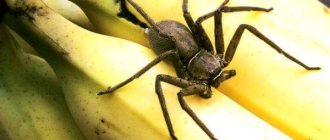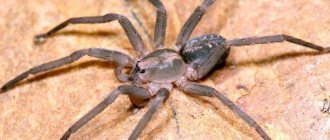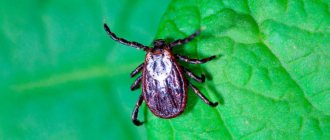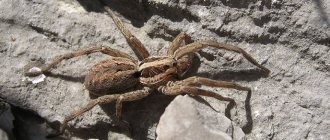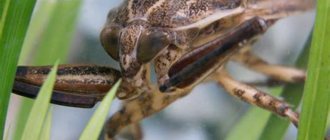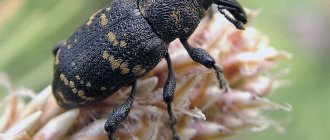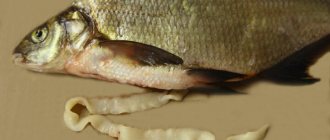Description
Latin name Saduria entomon. Belongs to the class of higher crayfish, order of isopods.
The water cockroach is often called a trilobite. But, if you look at the photo of a sea cockroach, it becomes clear that it looks almost like a land woodlouse. And this coincidence is not accidental. Woodlice also belongs to crustaceans from the order Isopods. These relatives differ in their rear part: the water cockroach has an elongated and pointed tail.
The size of the underwater cockroach is small: no more than 9 cm. In the Baltic Sea, the largest specimens are found at the bottom of the Gulf of Bothnia.
Interesting!
The largest sea cockroaches found by people were 10 cm long.
Although these isopods are not gigantic in size, they are officially recognized as the largest crustaceans of the Baltic Sea. Males are usually larger than females.
The color of isopods can be:
- gray;
- sandy;
- light brown;
- beige.
The color of a sea animal depends on the color of the bottom on which it lives and is of a camouflage nature.
Lifestyle and habitats
Sea cockroaches, like all crustaceans, live at the bottom of seas and lakes. They feed on plants or small representatives of the animal world found there, as well as small pieces of organic matter. Sea cockroaches do not disdain carrion, and in some cases they can profit from the flesh of their relatives. Even being protected by their shell, sea cockroaches often become a delicacy for large fish. Where does the sea cockroach live?
These crustaceans live in the Black, White and Baltic seas. They can be found in the shallow waters of the Pacific and Arctic oceans. For permanent residence, they prefer moderately salty water, but, despite the name, they can also exist in the fresh waters of some large lakes.
Why sea cockroaches are found in the waters of lakes in Scandinavia and Russia is not completely known. According to one version, they have remained there since when these lakes were still part of the sea. Another says that these crustaceans were able to get out of the sea on their own.
Body structure
The body shape is a long drop. The aquatic cockroach is covered with a shell, in addition to protection, which serves as an exoskeleton. The body is divided into 8 segments:
- cephalothorax;
- 6 back segments;
- the tail is the longest segment.
The arthropod's paws are attached to the four dorsal segments.
The head of a higher crustacean is protected from the front and sides by pointed plates. Between the plates there are eyes and short whiskers. Below are the gills.
The dorsal segments below also end in pointed plates with spines. Such high-quality protection allowed the animal to live unchanged since the last Ice Age, and perhaps longer.
Peculiarities
There are more than 80 species of sea cockroaches in nature. They live not only in salt water, but also in fresh water. Not everyone has seen what a sea cockroach looks like in a photo. The creature reaches a length of up to 10 cm, most often has a gray, brown, sand or white tint. This color helps the crustacean camouflage itself and be invisible to predatory fish.
The body structure of the sea cockroach has some peculiarities. The body of the crustacean, narrowed to the end, is covered by a protective shell divided into several segments. This kind of exoskeleton protects the arthropod from mechanical damage and various infections. As the crustacean grows, it is forced to periodically shed its chitinous cover, since over time it becomes cramped for it. This process of “changing clothes” is called molting. It is during this period that the marine inhabitant is able to increase the volume of its soft tissues.
Also on the body of crustaceans there are external and internal antennae (the latter are shorter). On the sides of the small head there are eyes and gills for breathing. The elongated linear body ends in a narrowed tail. Below is a photo of sea cockroaches.
Sea cockroaches live at the bottom of lakes or seas (mainly in the White, Baltic or Black Seas). Plants, remains of organic matter and small representatives of the animal world found there serve as food for arthropods. Crustaceans also prefer to eat carrion, and sometimes they can even feast on the flesh of their fellow.
Lifestyle
The sea cockroach is a predatory animal that feeds on amphipods, small shrimp and mollusks. The basis of the arthropod’s diet is the crustacean Monoporeia affinis.
But very soon the predator may face the problem of hunger. Monoporeia affinis is sensitive to the oxygen content in water. Due to decreased oxygen levels in the Baltic Sea, and especially in the Gulf of Finland, the population of Monoporeia affinis began to decline.
Interesting!
Saduria entomon can also feed on rotting plant remains and carcasses of animals and fish.
How to recognize a sea cockroach?
They have something in common with cats. The water cockroach has widely spaced, fixed compound eyes with over 4,000 individual facets. Cats and crustaceans (and many other animals) have a reflective layer at the back of the eye that reflects light back through the retina and enhances night vision. It is also what makes the eyes of cats and sea cockroaches glow.
They probably don't see very well... It's pretty dark where sea cockroaches live, so vision isn't an important factor for them or for many other deep-sea animals. They use other senses to maneuver, communicate, find food, and find mates.
Most likely they are using their antennas. Sea cockroaches have two sets of antennae which they use to experience the environment around them. Small antennas are used more for chemical sensing, while large antennas are used for physical sensing. When food appears in front of them, they can feel it physically and chemically. They may have a sensory receptor that responds to distortions in the water around them.
The oval flat body is protected by a strong segmented chitinous shell, which gradually tapers and ends in a rather long tail. Gray or gray-brown color allows it to reliably blend into its environment and become unnoticeable to other animals. This can be clearly seen in the underwater photos.
Is it possible to eat sea cockroaches?
Sea cockroaches can be eaten and will not cause any harm to you. Moreover, in Southern countries, such arthropods are specially caught at the bottom of the ocean to be served to guests as a delicacy, since the meat of this arthropod is rich in proteins, micro and macroelements. In Russia, seeing such a delicacy in restaurants would be a terrible sight.
But sometimes when you open a can of canned food, you may see a cockroach there. This happens because when fishing, water cockroaches often get caught in the nets. Unfortunately, fishermen do not always pay attention to this and do not throw them back.
But you shouldn’t be afraid, because because of the cockroach, the canned food will not be spoiled, but your appetite can spoil the appearance of what you see.
When sea cockroaches sense danger, they roll over. For example, if a fish wants to take food from a cockroach, the latter, in turn, turns over to protect its soft organs and food from attack. Only sea cockroaches have the ability to curl up so that they cannot be captured; other arthropods of their class can be easily caught. Water cockroaches may also hide in crevices to avoid detection.
What does the beaver eat?
They are predators. Although they are generally thought to be scavengers, feeding on dead animals, some evidence suggests they may also eat slow-moving living organisms such as sponges. Sea cockroaches also attack trawl catches.
Sea cockroaches have four sets of jaws that are adapted for cutting and tearing prey. When they are hungry and there is a lot of food around them, they will continue to eat a lot at one time, and then can go a long time without food. In fact, they eat so much that it compromises their ability to move.
However, they are not aggressive eaters. They definitely won't fight each other for food. Their favorite delicacies: caviar, small fish, other arthropods, remains of the inhabitants of the reservoir and algae.
Since food may be scarce in the deep sea, sea cockroaches limit their energy expenditure. They have a slow metabolism. The mechanics of their bodies are like this because they are deep sea creatures and do not find food all the time. Thus, they may slow down their metabolism and energy levels in order to survive. They don't move that much. Usually they just sit still.
How does a sea cockroach reproduce?
Want to tell males from females? Female sea cockroaches have a brood pouch, or marsupial, located on their underside where they hold 20 to 30 eggs. Males have two specialized organs: small white appendages that carry sperm and male appendages that they use to transfer sperm into females. They will insert this organ to transfer sperm anywhere inside the woman after she has moulted - because she becomes soft and can take that sperm.
They have the largest eggs of all marine invertebrates, up to 10 centimeters in diameter. Females do not eat when they are pregnant; instead, they bury themselves in the mud to reduce energy consumption and protect the eggs.
Their babies look like adult sea cockroaches. A nauplius is a larva that has just hatched from an egg. Juvenile sea cockroaches are approximately 5 centimeters long when they emerge. All they're missing is their last pair of legs; when they are fully grown, they will have a total of seven pairs of legs.
To grow, they shed their exoskeletons. Younger sea cockroaches often shed to grow larger, but when they get older, they don't shed as much. They are capable of molting, but they have already reached their size, so because they only need molting to grow.
Types of cockroaches with wings
Do cockroaches have wings? The domesticated Prussian can only jump from a height, gliding on its wings, when it is in danger - this applies mainly to males, since they are smaller in size and have longer wings. Females use them to attract the attention of males. Some do not have wings, such as the Madagascar and others that do not require them. But in nature there are ones that fly:
- Asian cockroach. About 1.6 cm long, very similar to the red one, but has longer wings, light brown in color, lives in the tropics of Asia, was recently discovered in the southern states of the USA, lives in grass and rotten leaves, unlike the red one - strives for light, there are cases of crossing with red.
- Cuban. Its dimensions are 6-8.5 cm, painted in a matte black color, its distinctive feature is a black mark on the pronotum, similar to a human skull or mask, which is why it was nicknamed “Death's Head”. One female gives birth to 20 to 30 larvae, which become adults after 6 months. They are often kept as decorative insects at home; the insect's lifespan is about a year.
- Green banana cockroach. About 2.5 cm in size, lives on banana plantations in America, flies very well.
- Smoky cockroach. It has American roots, size from 3.5 to 5 cm, has a red-brown color, flies well, lives in warm climates in grass, stumps, piles, garages, in case of cold weather it can fly indoors, adult individuals live up to 6 months. He is a cleaner by nature.
- Wood cockroach. Inhabitant of many areas of North America, its length is within 3 cm, there are smaller species. Males are capable of flying well, while females have underdeveloped wings. Lives in the bark of rotten trees, loves moisture, and is capable of migration in case of drought.
In any case, close proximity to red or black cockroaches in the house will not please anyone. Therefore, one of the preventive measures that any resident of an apartment building should do is timely cleaning of the kitchen area.
Features of the life of a sea cockroach
The sea cockroach lives along the coast at a depth of approximately 290 m. Most of its life it lives at the bottom of the reservoir; its favorite types of soil are sand, clay, gravel and mud. The sea cockroach swims quite poorly.
Its diet is varied: this crustacean can feed on plant debris, carrion, and even relatives, but it is also a predator. The sea cockroach preys on small organisms living on the bottom, for example, worm-like arthropods and small mollusks.
Reproduction in sea cockroaches occurs sexually; they are heterosexual creatures. The male fertilizes the female, after which she lays eggs in the ground. When the supply of nutrients is depleted, a larva emerges from the egg, and the first stage of development begins - nauplius.
The body of a sea cockroach larva consists of only two segments. She is quite vulnerable, because her chitinous cover has not yet hardened. As the crustacean grows, new segments form on the side of the tail.
Then comes the next stage of development of the sea cockroach - metanauplius. At this stage, the body of the larva has several segments, and the chitinous cover is already stronger. At this time, molting occurs, as a result of which the shell changes to a new, larger one. At this stage, internal changes of the sea cockroach also occur.
Description of domestic Madagascar cockroaches
The main concentration of cockroaches of this species is observed on the island of Madagascar, hence the name of the “breed”. Today, there are about 20 varieties of Madagascar cockroaches, distinguished by certain features of their appearance.
External data of insects:
- the body of a cockroach resembles a shell and is covered with a dense chitinous shell;
- color - from red in various shades to black;
- wide belly;
- males often have deformed mustaches and characteristic growths on the shell;
- in females, the last two segments of the shell are darkened (in males, one is darkened);
- can reach 9 cm in length.
The older the cockroach, the lighter its shell becomes. Before death, the insect's body becomes noticeably lighter.
Where does the sea cockroach live?
As already mentioned, the sea cockroach was able to survive the Ice Age; it is not afraid of the cold; it prefers to live in cold waters. Its main habitats are the coastal zone of the Baltic Sea, the Arctic Ocean and the North Pacific Ocean.
This crustacean can also be found in fresh water, in particular in the waters of European lakes: Venern, Vättern and Ladoga.
The sea cockroach is also an invasive species of the Black Sea, first noticed in 2009.
Sea cockroach on the bottom
Who is the sea cockroach and its other names
These are bottom dwellers. They also have another name - water cockroach. You can find these insects at the bottom of the Arctic Ocean, in the Pacific Ocean at a depth of up to 2500 meters. They prefer clay bottoms and hide there in a quiet, secluded place. They can also be seen in freshwater lakes.
They are considered giant insects; their body length can reach 9 centimeters. Scientists will explain this fact by saying that their size may be an adaptation in order to survive storms and extreme ocean pressure.
How do waterfowl cockroaches reproduce?
Crustaceans reproduce sexually both in an aquarium and in natural conditions. A larva emerges from the embryo, which has only 2 segments. Each time the chitinous cover comes off, new segments appear.
The transformation of the embryo includes several stages:
- The emerging larva does not have a chitinous cover, so the probability of its death is high.
- The growth zone is concentrated in the anal area. It is activated with every molt.
Each molt is accompanied by a change in size and an increase in meat. In the process, external characteristics also change. The adult looks like a crustacean or shrimp.
How long does a domestic cockroach live?
The life cycle and how quickly cockroaches grow after hatching depends, firstly, on the species of cockroaches, and secondly, on the external conditions where they live. The life of all cockroaches begins with the laying of eggs hidden in a capsule called an ooteca, then cockroaches pass through a series of larval stages and eventually develop into adult insects. Of the more than 4,000 species of cockroaches found in homes, the majority are red, black, and American.
How long does the Prusak cockroach live?
The female red cockroach sheds a capsule, or ootheca, containing 30-40 eggs 1-2 days before the newborn nymphs emerge. Depending on environmental conditions, the period of development from egg to adult in red cockroaches varies between 50-200 days, the average period is 100 days. The lifespan of adult Prussians is 100-200 days.
How long does a black cockroach live?
Male black cockroaches live on average 110-160 days, while females have a life expectancy of up to 180 days. During this time, they manage to lay 8-12 oothecae, 15-16 eggs in each. The period of development from egg to adult in black cockroaches includes 7-10 intermediate larval stages and depends on the ambient temperature.
When eggs appear in the summer months in warm climate zones, the development time takes up to 200 days, but in conditions of prolonged cold weather they can reach 800 days. The average development period is 500-600 days, so the total lifespan of black cockroaches is about two years.
How long does an American cockroach live?
The American cockroach is the largest (up to 50 mm in length) and long-lived representative of synanthropic cockroaches. The incubation period of eggs lasts 40-45 days, and the complete period of development to adulthood, which includes 10-13 larval stages, is 600 days. Adult males live up to 360 days, and females up to 700 days, so long-lived American cockroaches can live more than three years.
Life cycle features
Photos of sea cockroaches predominantly show mature individuals. However, how does the process of reproduction and development of such creatures occur? How is it different from breeding domestic cockroaches?
The process of reproduction occurs through sexual intercourse. Sea cockroaches are heterosexual creatures, with both females and males present. After a female is fertilized, she lays eggs.
Next, a certain cascade of transformations of the embryo occurs, which can be described by the following sequence of events:
- After the supply of nutrients in the egg runs out, the embryo emerges as a nauplius. This is a small larva that has only two segments in its body. Its chitinous cover is still very delicate and does not protect well from mechanical damage.
- Near the anus there is a so-called growth zone, which ensures the further development of the sea cockroach. Metanauplius is its next stage.
Subsequently, the maturing individual must go through a series of molts, during each process changing its internal and external characteristics. As mentioned earlier, sea cockroaches grow as long as their shell allows them to do so. As soon as it reaches the required size, we can talk about a sexually mature individual.
Fighting methods
Black cockroaches have a cautious behavior. Often, traps designed for common red locusts are ineffective at controlling these insects because they avoid spilled powder or chalk paths.
To completely eliminate large black parasites, it is recommended to call professional exterminators. If this measure is not possible for some reason, you can pay attention to the methods presented below.
Mechanical destruction
The emergency and at the same time the most common method of fighting insects is mechanical, that is, it involves the use of a folded fly swatter or an ordinary house slipper. However, large cockroaches can easily survive even receiving a fairly significant blow, which is due to the presence of strong chitinous elytra.
In addition, even if a large number of parasites are exterminated, there is always a risk of repeated invasion - several cocoons with larvae, carefully laid aside by females, can simultaneously hide in secret corners. Therefore, to effectively get rid of colonies, it is recommended to choose a more reliable method.
Heat treatment
When black cockroaches appear in the bathroom, kitchen or any other room, it is best to use the safest, time-tested method, the essence of which involves heat treatment of the room.
To use this method, you need to completely freeze the room, that is, turn off the heating and leave the house for a while.
The significant disadvantages of this method are the following: you can get rid of black cockroaches in this way only in a private home and only in winter. If unpleasant guests appear in the apartment, you should choose another, more suitable method for this purpose.
Repellents
The easiest way to get rid of black cockroaches in an apartment is to use repellents - products that are not destructive to parasites, but help repel them.
This species directly does not tolerate the pronounced smell of bay leaves, elderberries, and flowering rye . To get rid of black cockroaches, it is recommended to make small bouquets from the above plants, and then place them in places where parasites accumulate.
The use of repellents is a fairly effective measure only when it is necessary to prevent the appearance of parasites. If the colonies have already taken a fancy to the apartment, it will not be possible to get rid of them by using aromatic plants.
Traps
Cockroach traps are quite effective. The only drawback of this method is the lack of harmful effects on insect larvae. Traps are only suitable for exterminating adult individuals.
According to the characteristics of the action, these devices can be as follows:
- Traps with adhesive backing. Inside such devices there is a treat that attracts parasites. Once the insect gets inside, it can no longer get out. The obstacle can be a sticky base or a clever labyrinth.
- Traps equipped with electrodes. When insects get inside, this type of device produces a weak electrical charge that kills or immobilizes the black cockroach. A trap with electrodes is equally effective against different types of cockroaches.
- Contains an insecticide inside. The design of the trap is simple - inside there is bait containing a toxic substance. This remedy option is completely safe for pets. Some types of traps with insecticides are not aimed at keeping the cockroach inside; after eating the poisonous bait, the parasites go to their relatives, infecting them, thereby contributing to the death of the entire colony.
You can make a simplified version of the trap yourself . To do this, grease the inside of an ordinary glass jar with vegetable oil, and then place any delicacy inside. Leave the jar in a place accessible to cockroaches.
How does reproduction occur?
Sea cockroaches reproduce sexually, meaning new organisms are produced from germ cells. When the embryo, feeding on the yolk of the egg, emerges to the surface, it becomes a planktonic larva, which is called a nauplius. Initially, its body consists of two segments, and then new ones are formed in the growth zone located in front of the anal segment.
Scientists call the next stage of development of the larva metanauplius. In general, to achieve full development, the larva needs to undergo several molts, during each of which both external and internal transformations occur.
Is it possible to eat them?
Interesting information for many gourmets will be that the sea cockroach is edible. It tastes a lot like shrimp or crayfish. Its meat is an excellent source of protein and essential microelements.
The only point that may repel potential connoisseurs of exquisite taste is the appearance of such a snack. However, if many peoples of the world eat even ordinary domestic cockroaches, then one should not expect anything bad from their marine “brother”. In any case, everyone decides for themselves what exactly to try again. A sea cockroach treat can be something new and exciting.
Sources
- https://apest.ru/tarakany/2-vidy/60-morskie/
- https://KlopVred.ru/tarakany/morskoj-tarakan/
- https://domvred.ru/morskoj-tarakan/
- https://DomoVreditel.ru/tarakany/morskoj-tarakan
- https://protarakanov.ru/morskie-tarakanyi-opisanie-osobennosti-foto.html
- https://FB.ru/article/243878/morskoy-tarakan-sreda-obitaniya-stroenie-interesnyie-faktyi
[collapse]
Where does the common newt live?
Photo: Common newt in nature
Mixed, deciduous forests are suitable for the common newt to live in. These animals live and breed in stagnant or slow-moving bodies of water. On land they hide in bushes and can be found in parks, gardens, and forest belts. Open areas are avoided. The common newt is a very common creature. It lives almost everywhere. The only exceptions are some territories: Crimea, southern France, Portugal, Antarctica, Spain. The natural habitat depends on the subspecies of the common newt.
There are seven subspecies:
- Aretic. Lives in Greece, Macedonia, Albania and Bulgaria;
- Schmidtler's Triton. Found only in western Turkey;
- Ampelous. It is also called grape. It is distinguished by a low dorsal crest and lives in the north-west of Romania;
- Kosswig's Triton. He is also a resident of Turkey. You can meet such an animal on the southwestern coast;
- Lissotriton vulgaris vulgaris. This is a nominative species. Is the most common. Its natural habitat extends from Ireland to western Siberia. The differences of such an animal are a high dorsal crest, a pointed tip of the tail;
- Southern common newt. Its natural habitat is Slovenia, northern Italy, southern France;
- Triton Lanza. Lives in southern Russia, northern Armenia, Azerbaijan and Georgia.
Now you know where the common newt lives, let's see what it eats.
